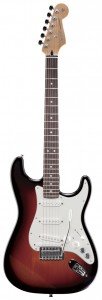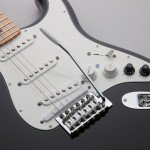The Rubens play a style of rock which is one part timeless guitar swagger and another part modern day production groove. The Roland Corporation, the innovative company responsible for many of the world’s most iconic keyboards has teamed with Fender guitars to release The G5, VG Stratocaster, merging a classic guitar model with futuristic technology to create a versatile guitar for the times. It made sense to put one of these units into the hands of The Rubens lead vocalist and guitarist Samuel Margin to get his opinion on the meeting of these two worlds.
 Reviewer: The Ruben’s Sam Margin
Reviewer: The Ruben’s Sam Margin
“When I was first asked to road test and review a bit of music equipment I was quite worried. I’d never been asked my opinion on anything like that before and wasn’t sure I could pull it off. When it was suggested that I review The Fender Roland G-5 guitar I was even more unnerved. It wasn’t as simple as reviewing a pedal like I’d hoped, but proved to be much more interesting!
I had the chance to play a Line 6 JTV-69US while I was in America and found it had many faults. It’s quite convenient for me to have something to compare the G-5 to, and quite convenient for the G-5 to have such a weak competitor… in my opinion.
Basically, Roland has taken its COSM guitar modelling technology and integrated it into a Mexican Stratocaster. This seems like a great idea in theory, but just because two things are successful on their own, doesn’t mean combining them will result in something equally successful. I’ve always been skeptical of these kinds of instruments, mainly because I feel like they are destroying the romanticism surrounding the guitar. The idea that you can now buy one guitar that can do the work of six is extremely practical, but not traditionally ‘Rock and Roll’.
 The first thing you will notice about this guitar when you pick it up is the high build quality. Mexican Strats can be a little bit hit and miss sometimes, but this guitar actually feels like an American Standard Stratocaster. This is really important to me especially if I was to be performing on stage with this thing. The fact that it looks and feels like a normal Strat helps distract you from the mutant it contains and I’m sure its subtlety will be a great selling point (though the blue LED does constantly remind you that there’s something fishy going on).
The first thing you will notice about this guitar when you pick it up is the high build quality. Mexican Strats can be a little bit hit and miss sometimes, but this guitar actually feels like an American Standard Stratocaster. This is really important to me especially if I was to be performing on stage with this thing. The fact that it looks and feels like a normal Strat helps distract you from the mutant it contains and I’m sure its subtlety will be a great selling point (though the blue LED does constantly remind you that there’s something fishy going on).
Let’s take a look at the spec sheet and see what this beast consists of. The guitar features an alder body, c-shape maple neck and
rosewood fingerboard. It has a vintage-style synchronised tremolo and three single coil pickups. Controls include a Mode knob which will gets you a modeled Strat, modeled tele, modeled humbucking, modeled acoustic guitar and there’s a non-modeling mode. The Tuning knob offers normal tuning, drop D, Open G, D modal, Baritone and 12 string guitar. Pretty impressive! There’s also a tone control knob, volume knob and five-way switch.
I am easily confused by technology, and I’m a terrible decision maker. I should have been completely daunted by such a guitar, but I wasn’t. I could’ve very easily become frustrated with the complexity of the different models but the truth is, I was just having way too much fun playing it to find it draining. I slowly tried different settings and through trial and error, became pretty at ease with the system quite quickly. I must admit I did begin to favour a few settings, particularly the Telecaster. It is actually phenomenal how much it sounds like you’re playing a Tele. The baritone guitar was equally as impressive. And there was absolutely no latency issues
 This guitar could really be used in a wide range of settings. For guitarists in cover bands its surely going to become a must-have!
This guitar could really be used in a wide range of settings. For guitarists in cover bands its surely going to become a must-have!
They could go from Hendrix to Jack Johnson with the flick of a switch. Actually, the acoustic guitar is really great too with the tone knob becoming a reverb knob when you choose this setting, another fantastic feature obviously great for using live. Although I can imagine most purist producers and engineers would turn their nose up at the idea of using the G-5 in the studio, more open minded types would benefit from having this guitar as their general studio ‘work horse’. Especially because although you have an amazing array of technology at your disposal, it can all be turned off and be used as a “classic” Strat.
It could also be an inspirational writing tool thanks to the tuning options. Being able to flick a switch and change from open tuning to drop-D and so on definitely helps when trying to get inspired and come up with a tune!
Looking back at this review its seems as though it has been a good one. I guess I like the G-5. I didn’t really expect to but Fender and Roland have really covered all the bases on the this one and left me no choice. I think the reason for its success is its relative simplicity. If I had to find something negative to say I’d only be able to find something as trivial as the fact that it doesn’t come with a hard case. If they are hoping for this guitar to be taken as seriously as the price tag suggests, (around $1500) they could throw in a Fender Hard-case.
If I’m going to be completely honest, and I am, I wouldn’t buy one of these guitars because I don’t need one. In saying that, there are countless musicians out there whose lives will be made so much easier by this amazing mash-up of technologies and because of that, I think Fender and Roland have produced something special in the G-5.”
Credit: Australian Musician Magazine



